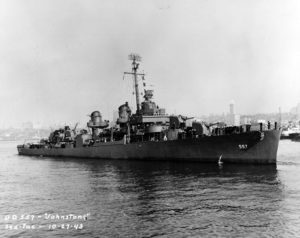- Author
- Letter Writer
- Subjects
- Letter to the Editor
- Tags
-
- RAN Ships
- None noted.
- Publication
- June 2021 edition of the Naval Historical Review (all rights reserved)
One of our most senior members, David Mattiske, who served in HMAS Shropshire in the Battle of Leyte Gulf and who maintains a keen interest in news from this famous naval battle, contacted the editor to bring him up to date with the following recent media reports.
In early April 2021 an announcement was made that an expedition carried out by two former USN officers has successfully relocated, surveyed and filmed and confirmed the wreck of USS Johnston (DD-557), the world’s deepest known shipwreck at a depth of 21,180 feet (6,456 m) off the Philippines.
Retired USN Commander Victor Vescovo piloted the submersible DSV Limiting Factor down to the wreck during two separate eight-hour dives. These are the deepest known wreck dives in history using manned or unmanned vessels.
The wreck was originally discovered in 2019 by the famous vessel RV Petrel under the leadership of the renowned explorer Robert Kraft. On that expedition they were unable to continue further as the majority of the wreck lay below the ROV’s rated depth limit of 20,000 feet (6,000 m). Accordingly, they were unable to confirm the identity of the ship.

USS Johnston was a Fletcher-class destroyer that sank in battle on 25 October 1944 during an intense engagement against Japanese forces during the Battle of Leyte Gulf. Rear Admiral Samuel Cox, Director of Naval History, said: ‘Commander Ernest Evans and his entire crew went above and beyond the call of duty engaging an overwhelming and vastly superior Japanese force to buy time for the escort carriers he was charged with protecting, to escape. The Johnston was awarded a Presidential Unit Citation – the highest award that can be given to a ship. Evans was awarded a posthumous Medal of Honour, the first native American in the USN (of Cherokee Indian ancestry) and the only destroyer skipper in WWII to be so honoured’.
The destroyer escort USS Evans (DE-1023) was named in honour of Commander Ernest Evans. This should not be confused with the destroyer USS Frank E. Evans (DD-754) which infamously was in collision with HMAS Melbourne on 3 June 1969.

The world’s deepest shipwreck




